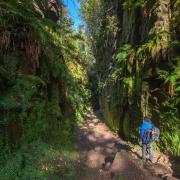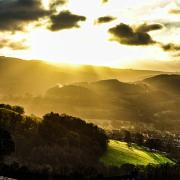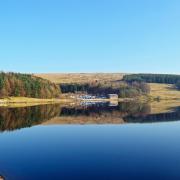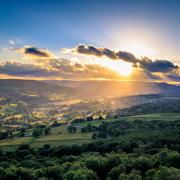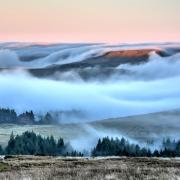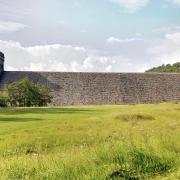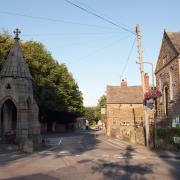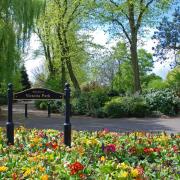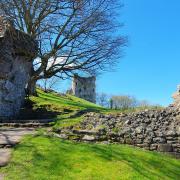Mike Smith explores a small High Peak village with Royal roots
In the years following the Norman Conquest, a vast area of the Peak District, bordered by the rivers Etherow, Derwent, Wye and Goyt, was reserved as a royal hunting forest.
By the 16th century, the number of deer in the Royal Forest had been reduced so drastically that it became necessary to create an enclosed area to preserve the remaining stock.
The foresters who managed this protected plot lived in a settlement that evolved over time into the village that we know today as Peak Forest.
Sheltering in a dip below Tideswell Moor, the village is surrounded by an extensive rolling landscape of pastel-green fields subdivided by drystone walls of light grey stone.

Because the chapel stood on Crown land, it was free from episcopal jurisdiction, allowing the minister of the parish to grant marriage licences without reference to the bishop of the diocese.
When it became known that the minister was willing to marry couples ‘from anywhere, at any time, without the need for banns’, runaway couples began descending on the village in increasingly large numbers.

Although the granting of special licences was supposedly prohibited by a further Act of Parliament in 1803, subsequent minsters managed to by-pass the legislation by allowing couples to be married if one of the intendeds had been resident in the village for 15 days immediately prior to the ceremony.
Although this arrangement, which was a nice source of income for both the church and the local hostelries, ceased long ago, Peak Forest is still known as ‘Derbyshire’s Gretna Green’.
Charles, King and Martyr
Showing me around the replacement church that was built in 1876, churchwarden David Pearson says: ‘Because the size of the nave is far too big for the number of people from the village who normally make up the congregation, we conduct most of our services in a side chapel.

‘However, the nave contains much of interest, including two very prominent stained-glass windows.’
The large east widow is dedicated to Lord Frederick Cavendish, chief secretary for Ireland, who was murdered at Phoenix Park in Dublin in 1882, and Lord Edward Cavendish, who had laid the foundation stone for the new church.
A window in one of the aisles depicts King Charles I and contains a gruesome depiction of the block and axe used at his execution. The church is one of the few places of worship in the country dedicated to ‘Charles, King and Martyr’.
When the original chapel was demolished to make way for its over-large Victorian replacement, its splendid Palladian window was re-used in the frontage of a new reading room, which forms an impressive and unexpected sight when viewed by motorists passing through the village.
The building is now used as a pre-school facility, called ‘The Peaks’, linked to Peak Dale and Peak Forest Schools.
On the other side of the A623, there are two other important village buildings.

They are Peak Forest CE Primary School, which has been described by OFSTED as ‘providing good education’ for up to 30 children, and the Devonshire Arms, a former coaching inn, containing seven rooms, all en-suite, made available to tourists who come to enjoy the bucolic countryside surrounding Peak Forest.
Although the pub is described as ‘a traditional country inn’, boasting ‘good food, good beer, good atmosphere, it has been modernised internally. In the grounds, there is a beer garden and an area made available for camping.
Woodland Federation
The school belongs to the Woodland Federation of Peak District Schools, with the other members of the group being the CE primary schools at Great Hucklow and Stoney Middleton.
Andrea Tomlinson, the executive headteacher with management responsibility for all three schools, explains, ‘One advantage of the federation is that it enables the sharing of educational visits and activities such as music and sports which require specialist teaching.’

Summarising the educational opportunities provided for the children of Peak Forest, Andrea says: ‘All the children have a chance to shine and they are encouraged to celebrate and appreciate the wonderful environment in which we live, including our two woodlands, where we provide a chance for the children to develop various outdoor skills.’
The children also have swimming lessons every week at the pool in Buxton and, as pupils of a ‘Bronze Rights Respecting School’, they learn about their global neighbours, which Andrea regards as ‘a means of counteracting the insularity which could be experienced by children living in a small, isolated rural community’.
Every July, a well dressing picture made by the children is displayed in an area of the village known as Old Dam.
When choosing a theme for their picture last year, the children decided they would celebrate the vital work of the NHS during the Covid outbreak.
Their picture even included a reference to the shortage of toilet rolls during the pandemic. This year, their picture will celebrate the Queen’s Platinum Jubilee.

At the blessing of the well, conducted by Rev. Carl Edwards, they will sing a special song which they have rehearsed at school.
After enjoying this performance, the villagers will walk down Church Lane to the grounds of the church, where the ‘adult well’ will be on display.
This second dressing, crafted by Emma Fox, Helen Shaw-Croft, Sarah Thompson and Sally Baker, will also commemorate the Queen’s Platinum Jubilee, after celebrating the 70th anniversary of the Peak District National Park last year.
Emma tells me that the dressing is just one of many community events that take place in Wakes Week. Others include a scarecrow competition, a car treasure hunt, a beetle drive, a village picnic and a 10km fell race.
To Old Dam
Walking along Church Lane, the road linking the locations of the two dressings, on the perfect spring day of my visit, I encountered wonderful countryside scenes.

I saw campers setting up their tents in a farmer’s field, watched lambs gambolling in an adjacent field, and paused to talk to Dave Rice of Elm Tree Farm, who was giving his son, Alex, a treat by allowing him to ride on his tractor.
After glancing across the road to take in a view of a former Wesleyan Chapel, now converted into a private house, I continued to Old Dam, where I spotted a well-preserved water pump.
Hereabouts, there was once a large pond that powered a corn mill. The pond is no longer there, nor is the mill, but a cluster of cottages remains, forming the enclave of Old Dam.
This picturesque hamlet is an appropriate place to conclude a visit to Peak Forest, because it was one of the first settlements to be established in the Royal Forest of the Peak, the hunting forest that gave the village its name.








